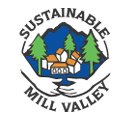

 |
 |
Cities for Climate Protection Campaign Survey Responses The Issue The Mill Valley City Council has passed the Cities for Climate Protection Campaign resolution committing the City to determine a baseline and set targets to reduce our community’s greenhouse gases. Will you support setting targets and how will you implement them? (See http://www.iclei.org/index.php?id=800 for background information) Maureen Parton Yes. I will support setting targets for the City. At the national level, our leadership has simply refused to address climate change and is not stepping up to the challenge. As a result, addressing climate change on a local level is imperative. The Cities for Climate Protection Campaign is a well-documented step-by-step approach that sets up an elegant framework for undertaking this vital work. Actions After analysis, we need to move onto the other steps including:
I applaud the current council for doing this work and I will support taking the next step. I will ask the council to work with staff to get this issue on the city’s front burner and made a part of the city’s official work plan. Then, I will ask the council to convene a citizen task force to work collaboratively to set the stage for arriving at a successful community- supported action plan for greenhouse gas reduction. The goal is to develop a local action plan that sets forth the policies and programs that the city will take to reduce greenhouse gas emissions and achieve the targets. As with all strategic plans, this one must include a timeline, financing, and the party responsible for taking action. A broad public education and awareness outreach would include a process for dynamic public input and involvement with the goal of building the kind of commitment that brings success. Ken Wachtel I will actively promote Mill Valley's continued participation in ICLEI's Cities for Climate Protection (CCP) program. Mill Valley, through a collaborative effort with the County, has already completed the first step of this program by establishing our GHG baseline inventory. The next steps are to affirm a GHG reduction target, develop a GHG reduction plan, implement the plan, and monitor and report results. I will join my colleagues on the City Council to ensure that these steps are followed through in a timely and effective manner, without delay. Grants from larger regional agencies are also becoming available for climate protection work and I will work to secure these grants. Stephanie Moulton-Peters I strongly support a CO2 measurement and reduction program and would not wait for AB 32 regulations to get this effort going. There is no reason why every aspect of the City of Mill Valley’s operations should not be subjected to close scrutiny to determine where and how energy reduction and conservation targets can find the greatest reductions in CO2. There is a wide range of things that need to be done to reduce our carbon footprint, and the place to start is with the areas that generate the most impact - transportation and the built environment. It starts with taking an inventory of the operations that are having the impact, in this case, the ones that are producing carbon emissions, and follows a defined process including developing measurements, setting targets, developing and implementing the plan, measuring results, modifying the plan and continuing the effort to reach targets. Mill Valley, through a collaborative effort with the County, has already completed the first step of this program by establishing our Green House Gas (GHG) baseline inventory. The next steps are to set an aggressive GHG reduction target, develop and implement a GHG reduction plan, and monitor and report results. If elected, I will do my best to ensure that Mill Valley follows through with the next steps expeditiously. In my estimation, there are three areas where the City will see the most opportunity to reduce energy usage and greenhouse has emissions: 1) energy efficiency improvements (heat and lighting) in older city owned facilities including City Hall, the Golf Clubhouse, the Repair Shops and Automotive Maintenance Facility at the Corporation Yard; 2) fuel efficiency in the City’s automotive fleet, 3) increased efficiency in the motors for the storm water discharge pumps on Corte Madera del Presidio Creek at Sycamore Park and the pumps at the Sewerage Agency of Southern Marin (SASM), on Sycamore Ave. The “change process" required to reduce carbon emissions in city owned facilities and in private homes and businesses is much like the environmental “change process" I managed in my professional career at PG&E. In the early 80’s, federal and state laws were passed to regulate the use, storage and disposal of toxic substances. Many changes to the facilities and the operating procedures were required to comply with the new standards. The change process was as much an effort to find ways to reach people with the message that things needed to change and to motivate change of many long held individual behaviors, as it was an effort to engineer new solutions and institute changes to long established policies and procedures. I successfully helped PG&E navigate that change process and I am confident that I can help the City and the residents of Mill Valley make the changes needed to reduce our carbon foot print. George Gordon The city has a conflict of interest in this area. The main revenues of Mill Valley are property tax, sales tax and fees. In all areas they make statements that they favor any and all methods for not adding to the problem, but consistently advocate more building, higher fees and increased sales tax revenues. You can’t have it both ways. |
||||
All text and images on this site © 2002-2007 Sustainable Mill Valley  Last updated: 10/12/07 |
||||